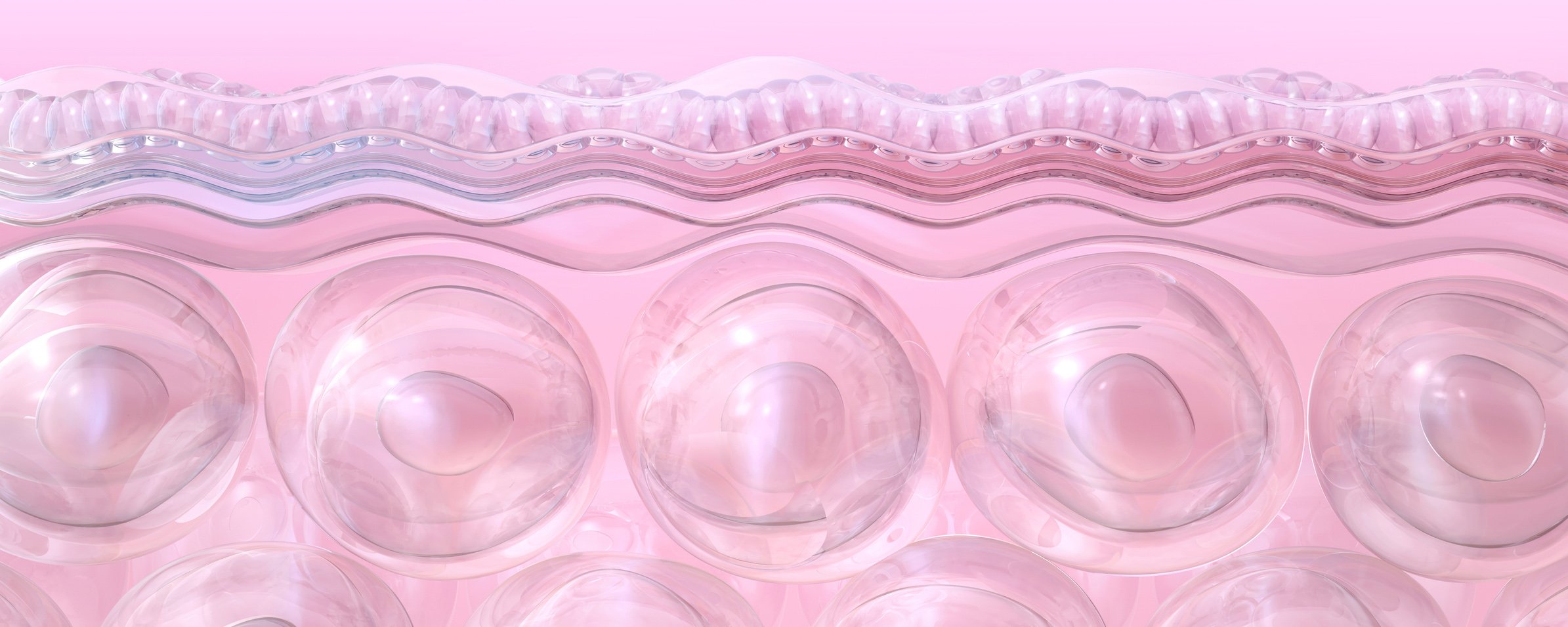Ornamental plants are considered allergen-free and therefore often not considered as their cause in housebound symptomatology. At the latest since the description of Ficus benjamina as an inhalation allergen in occupationally exposed gardeners and also in non-occupationally exposed atopics and even in non-atopics, attention has been drawn to the importance of this ornamental plant. Not only Ficus benjamina, but also other green plants (Tradescantia, Albifloxia, Schefflera, Spathiphyllum, Flamingo tree, Wax flower, etc.) are potential inhalation allergens, even for non-atopics, and must be tested natively (prick-prick, scratch) and serologically (specific IgE determination in case of certain suspicion) in case of clinical suspicion. In vitro diagnostics are available to the primary care physician to exclude or confirm sensitization to domestic inhalant allergens in perennial rhinopathy or in perennial bronchial asthma; only IgE determination to Ficus benjamina can be routinely performed on green plants.
In case of annoying rhinitis, eye itching, cough, asthmatic complaints or skin rashes in the morning after waking up, when making the bed, vacuuming, in general in case of house-bound symptoms, a “house dust allergy” is thought of. Inhalant allergies to allergenic components of house dust are of particular clinical importance because of the continuous exposure and consequent triggering of year-round symptoms. Since the discovery of the Pyroglyphidae (house dust mites) as the major dust allergens [1,2], a number of other inhalant allergens that are components of house dust, among others, have been identified. Thus, other insects such as silverfish and dust bunnies [3], animal epithelia, especially cat epithelia [4,5], cockroaches (Blatella germanica) [6] and the berlin beetle (Trogoderma angustum), but also mold spores [7], the hemoglobin of Chironomidae [8] as a component of fish food [9] and wild silk in comforter fillings [10] have been recognized as potent inhalant allergens. Although these allergens do not have the same epidemiological significance as sensitization to house dust mites, their identification is nevertheless of considerable importance to the individual patient in terms of allergen elimination.
Ficus benjamina: a new inhalant allergen
In 1985, Axelsson et al. first pointed out Ficus benjamina as an inhalation allergen in occupationally exposed gardeners and sellers of garden and house plants [11]. Later, they also reported non-occupationally exposed atopic patients who were sensitized by contact with the plant and suffered from corresponding respiratory symptoms [12]. We ourselves, as shown in case description I, were able to diagnose several cases of nonoccupational allergy to Ficus benjamina, also with monovalent sensitization, in our polyclinics [13,14] (Fig. 1).

Since Ficus benjamina (birch fig), a plant species from the mulberry family (Moraceae), is a popular and widespread ornamental plant, increasing sensitization to this ornamental plant must still be expected in our country. The allergen is localized in the latex and is either released when leaves and branches are cut, or is probably delivered by excretion to the leaf surface, where it can bind to the dust lying on it and lead to the corresponding respiratory symptomatology. Other well-known representatives of the Ficus familyare Ficus carica with the edible fig as fruit body and Ficus elastica, the Indian large-leaved rubber tree, from which rubber is also obtained. However, other green plants, as the other case studies show, can trigger rhinitis and asthma attacks occupationally and when symptoms are tied to the home.
In addition to the allergies caused by the Ficus family, a whole range of other allergies to ornamental plants exists:
- Allergy to the ornamental green plant Tradescantia (Albifloxia, three-master flowers) (case report II): Three-master flowers (Tradescantia), also called God’s eyes, are a genus of plants in the Commelina family (Commelinaceae). Many Tradescantia species with different colored leaves are kept as houseplants. Undemanding plant is one of the most famous hanging basket plants. We described an indoor allergy to a green plant of the genus Tradescantia (synonym: Albifloxia) (T. fluminensis and T. albifloxia) with green leaves or with white stripes [15] (Figs. 2A and 2B).
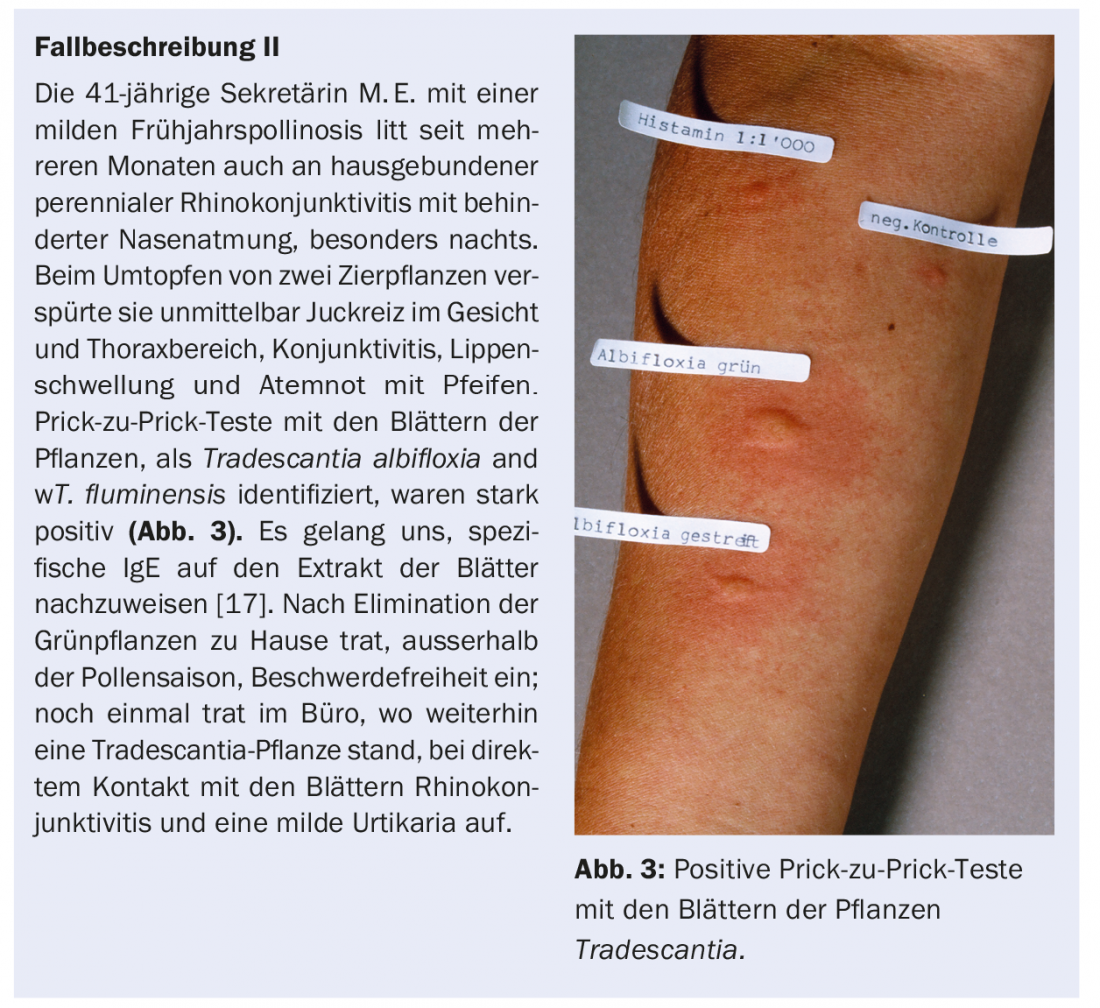

- Indoor allergy to Spathiphyllum floribundum (case description III): Spathiphyllum, or in German Scheidenblatt, Blattfahne, Einblatt or also Friedenslilie, is a plant genus, which belongs to the family of the Aronstabgewächse (Araceae). Some species are kept as houseplants for their decorative leaves. After an occupational allergy to Spathiphyllum waltisii was described [16], we were able to report a non-occupational indoor allergy to Spathiphyllum floribundum) [17].
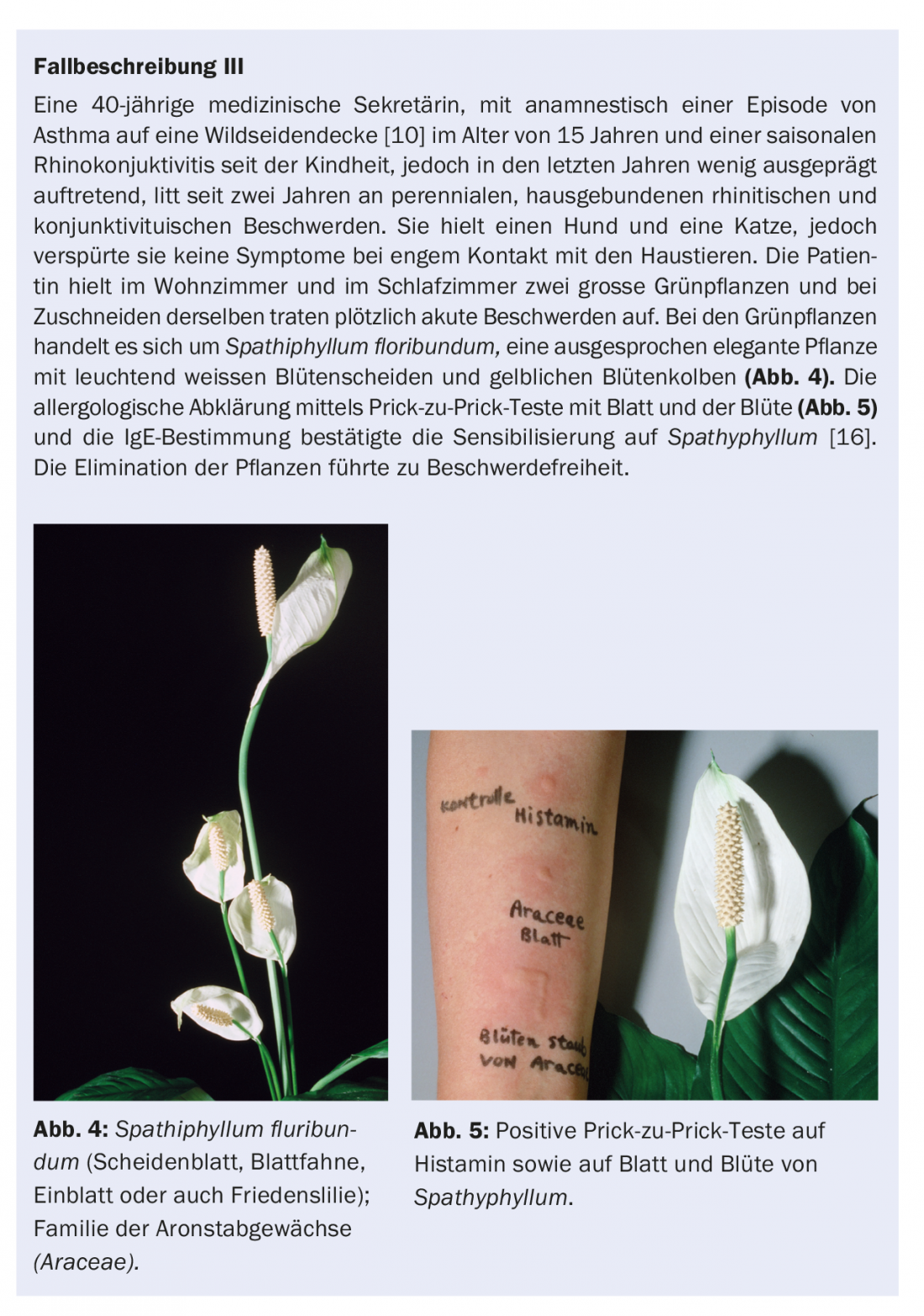
- Occupational Allergy to Schefflera (Ray Aralia) (Case Description IV): The Schefflera or Ray Aralia is a genus of plants in the Aralia family (Araliaceae) and is widely distributed in tropical areas. The family contains more than 200 species. Outside tropical and subtropical regions, five species grow only in plant nurseries; common species are S. actinophylla and S. arboricola (Fig. 6). Allergic contact dermatitis to the ingredient falcarinol of Schefflera arboricola has been reported [18]. We described the first case of occupational inhalant allergy to Schefflera [19].
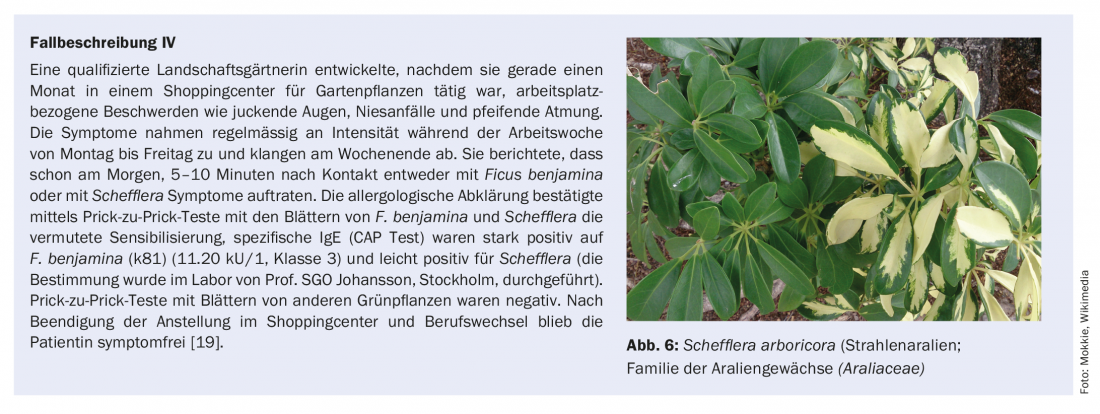
- Indoor allergy to yucca and philodendron (case description V): Yuccas from the Agavaceae (agave) family are popular indoor plants today. It is mainly the species aloifolia that is cultivated, and its sharp leaf tips are dangerous (Fig. 7). Kanerva et al. [20] described occupationally triggered allergic contact urticaria to yucca – with a simultaneous sensitization to Ficus benjamina and Spathiphyllium. The philodendrons (Philodendron), also called tree friend, are the only genus of the tribus Philodendreae in the subfamily Aroideae within the plant family of the Arum family (Araceae) (Fig. 8). One of the authors (M.A.) was able to diagnose and clarify a case of allergy to Yucca and to Philodendron bipennifolium and to prove an allergy by means of basophil stimulation test with plant extract as well as positive nasal provocation to Ph. bipennifolium [21].
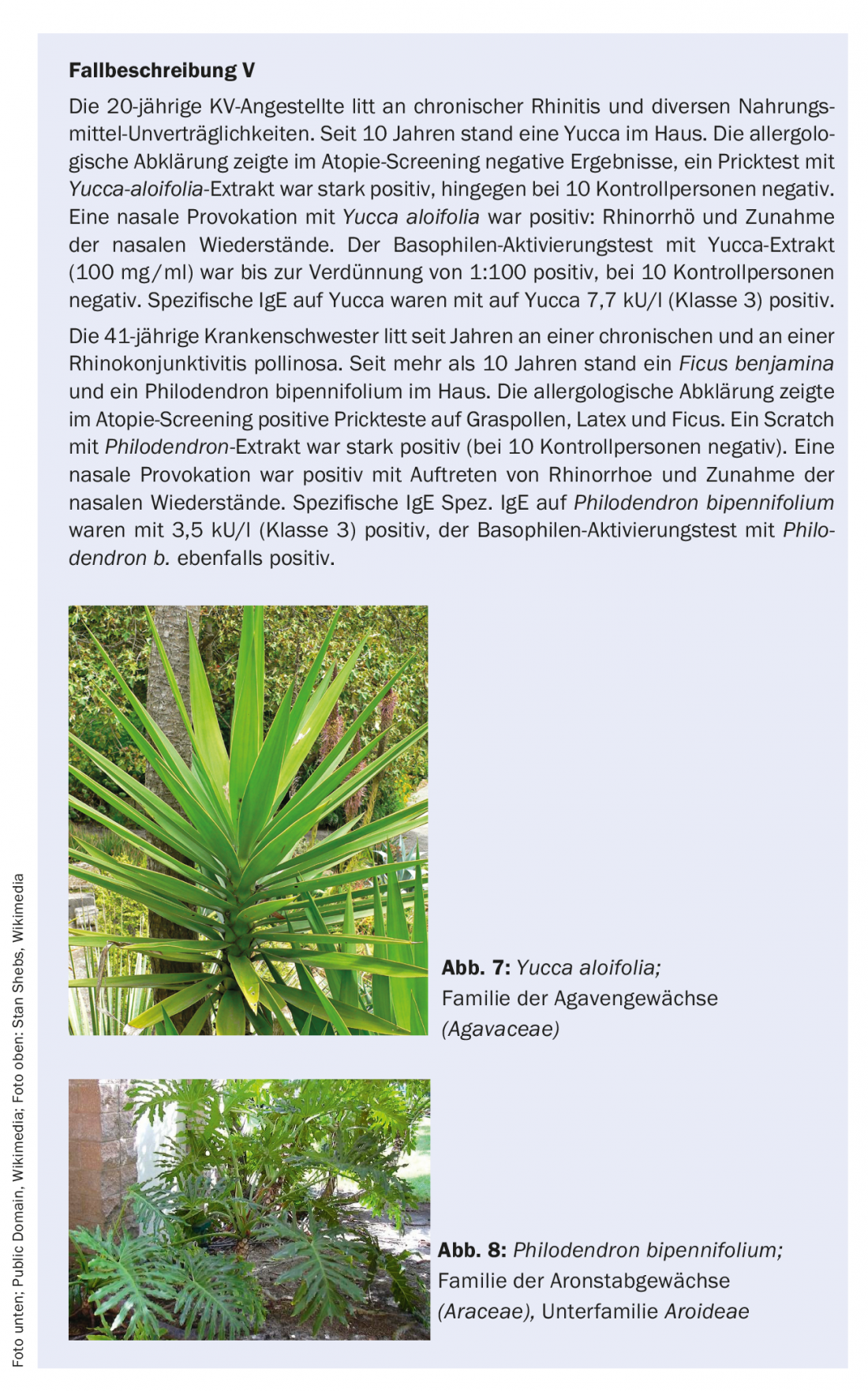
Clarification for indoor allergens in the practice
The cases described above and other literature reports impressively show that not only Ficus benjamina, but with an increasing number of ornamental plants also others (Tradescantia, Albifloxia, Schefflera, Spathiphyllum , Flamingo tree, Wax flower, Spurge family [Euphorbiaceae], date palms, etc.) [22–27] are potential, ubiquitous (office, home) inhalation allergens and occupational allergens – also for non-atopics – which must be tested allergologically (prick-prick, scratch or rub test with native material) in case of clinical suspicion (symptoms during repotting, cleaning of leaves, housebound symptomatology without sensitization to routine allergens, contact at the workplace, occupational contact, etc.). However, the irritant and toxic properties of certain plants must be taken into account.
In the case of perennial symptoms of rhinitis, conjunctivitis, cough or asthma, if the medical history does not already provide evidence of possible triggering inhalation allergens (house dust mites, animal dander, flour dust), the general practitioner can perform an in vitro allergy exclusion diagnosis with determination of an inhalation screen (e.g. SX1 or Phadiatop [ThermoFisher-Phadia]). These two tests are positive in case of atopic diathesis and sensitization to common inhalant allergens and pollinosis, because specific IgE to birch, grass and mugwort pollens are also determined, so they are not of further diagnostic help. In the absence of any anamnestic evidence of pollen allergy, the perennial screen (rx2) or, even more sensibly, the indoor mixture (rx5) can be determined, supplemented if necessary with inhalation allergens to which exposure occurs at home (guinea pigs, animal epithelia, etc.) (Tab. 1) .
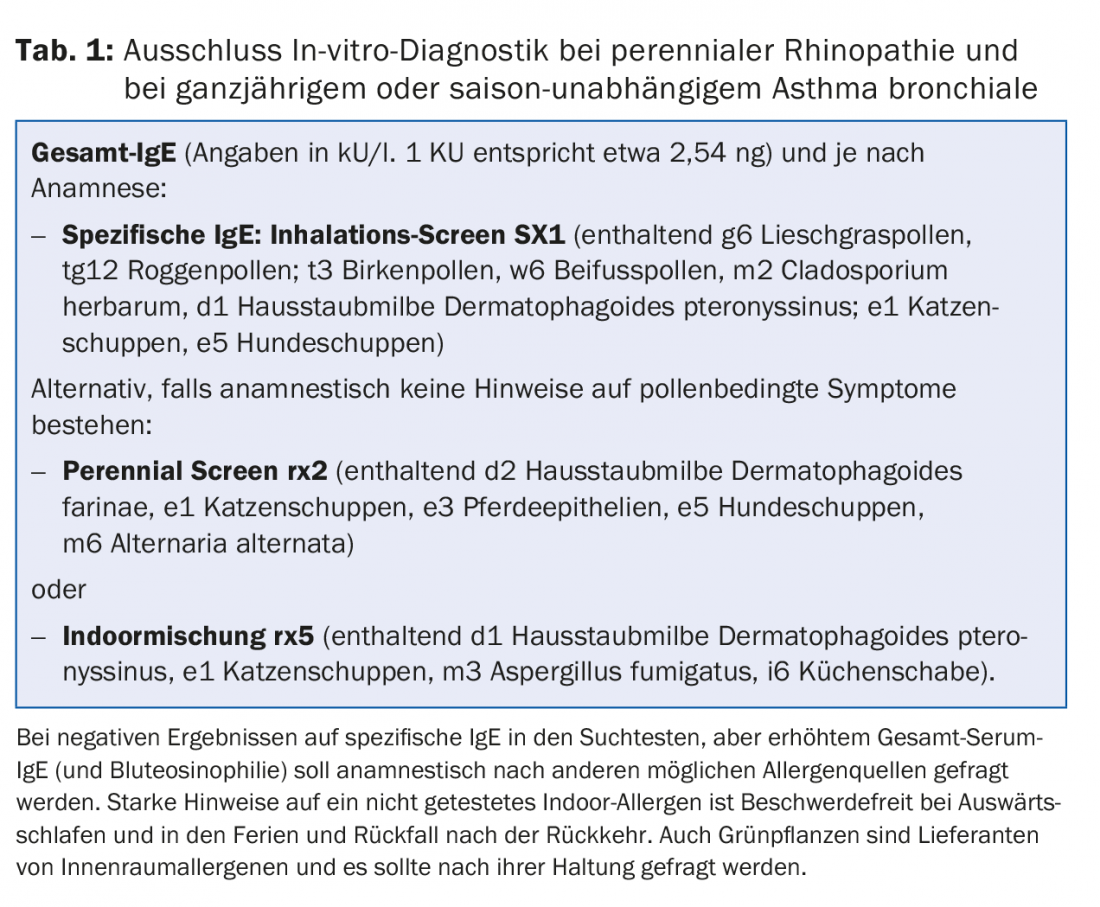

If allergy to an indoor allergen is specifically suspected, allergen-specific IgE can be determined (Tab. 2). However, it must be explicitly pointed out that a positive result in the specific IgE determination – as, by the way, also a positive skin test – only indicates a sensitization that has occurred (possibly due to cross-reactions), but not the actuality of the allergen for the symptomatology present (latent sensitization, clinical significance in an earlier phase of life, e.g. in childhood). If the history is not sufficient to determine the clinical relevance of the allergen, provocation tests (nasal, bronchial) must be used. These belong in the hands of the allergy specialist. Except for Ficus spp., unfortunately, specific IgE to green plants cannot be determined routinely, so that the help of the allergist must be sought here as well. A possible cross-sensitization of Ficus-benjiamina allergenwith the edible fig (Ficus carica), exotic fruits (avocado, pineapple, kiwi, banana) should be mentioned here only briefly [28,29]. In our evaluation of positive IgE to Ficus b. (> 0.7 kU/l, CAP FEIA, Allergy Laboratory USZ) during one year in 28 patients, 25 patients (75%) also showed sensitization to fig. [28]In some sera, evidence of cross-reactivity with latex from Hevea brasiliensis, the potent allergen in latex-containing rubber articles, was found [30], whereas in five of our patients, no Hevea brasiliensis latex allergycould be identified either anamnestically, in skin testing, or in vitro [14].
Take-home-message
- Ornamental plants are considered allergen-free and therefore often not considered as their cause in housebound symptomatology.
- At least since the description of Ficus benjamina as an inhalation allergen in occupationally exposed gardeners and also in non-occupationally exposed atopics and even non-atopics, attention has been drawn to the importance of this ornamental plant.
- Not only Ficus benjamina, but also other green plants (Tradescantia, Albifloxia, Schefflera, Spathiphyllum, Flamingo tree, Wax flower, etc.) are potential inhalation allergens, even for non-atopics, and must be tested natively (prick-prick, scratch) and serologically (specific IgE determination in case of certain suspicion) in case of clinical suspicion.
- In vitro diagnostics are available to the primary care physician to exclude or confirm sensitization to domestic inhalant allergens in perennial rhinopathy or in perennial bronchial asthma; only IgE determination to Ficus benjamina can be routinely performed on green plants.
Literature:
- Voorhorst R, Spieksma-Boezeman M, Spieksma F: Is a mite (Dermatophagoides sp.) the producer of the house-dust allergen? Allergy Asthma 1964; 10: 329-34.
- Wüthrich B: On the significance of the mite Dermatophagoides pteronyssinus for house dust allergy. Schweiz Med Wochenschr 1970; 100: 921-7.
- Rijckaert G, Thiel C, Fuchs E: Silverfish and dust lice as allergens. Allergology 1981; 4: 80-6.
- Guérin B, Hewitt B, Wüthrich B: Poussière de maison: activité corrélée de trois types d’extraits de poussière par rapport aux extraits d’acariens, fourrure de chat et squames humaines. Rev fr Allergol 1981; 21: 217-20.
- Ammann B, Wüthrich B: Significance of animal epithelia as “house dust allergens”. Dtsch Med Wochenschr 1985; 110: 1239-45.
- Mosimann B, Peitrequin R, Blanc C, Pecoud A: Allergie aux blattes (cafard) dans une population suisse souffrant d’asthme et de rhinitie chronique. Schweiz Med Wochenschr 1992; 122: 1245-8.
- van Bronswijk J: A century of house dust research from an allergological perspective. Allergology 1988; 11: 206-11.
- Baur X, et al: Hypersensitivity to chironomids (non-biting midges): localization of the antigenic determinants within certain polypeptide sequences of hemoglobins (erythrocruorins) of Chironomus thummi Diptera). J Allergy Clin Immunol 1982; 68: 66-76.
- Knüsel J, Wüthrich B: “Aquarium allergy”: fish food, also a domestic allergen. Schweiz Med Wochenschr 1983; 113: 658-62.
- Häcki M, Wüthrich B, Hanser M: Wild silk: an aggressive inhalant allergen. Dtsch Med Wochenschr 1982; 107: 166-9.
- Axelsson I, Skedinger M, Zetterström 0: Allergy to weeping fig – a new occupational disease. Allergy 1985; 40: 461-4.
- Axelsson I, Johansson S, Zetterström 0: A new indoor allergen from a common non-flowering plant. Allergy 1987; 42: 604-11.
- Schmid P, Stöger P, Wüthrich B: Severe isolated allergy to Ficus benjamina after bedroom exposure. Allergy 1993; 48: 466-7.
- Bircher A, Wüthrich B, Langauer S, Schmid P: Ficus benjamina, a perennial inhalant allergen of increasing importance. Schweiz Med Wochenschr 1993; 123: 1153-9.
- Wüthrich B, Johansson SGO: Allergy to the ornamental indoor green plant Tradescantia (Albifloxia). Allergy 1997; 52: 556-9.
- Kanerva L, Makinen-Kiljunen S, Kiistala R, Granlund H: Occupational allergy caused by spathe flower (Spathiphyllum waltisii). Allergy 1995; 50: 174-8.
- Cahen YD, Lundberg M, Wüthrich B: Indoor allergy to spathe flower (Spathiyllum floribundum). Allergy 1997; 52: 114-15.
- Hansen L, Hammershoy 0, Boll PM: Allergic contact dermatitis from falcarinol isolated from Schefflera arboricola. Contact Dermatitis 1986; 14: 91-3.
- Grob M, Wüthrich B: Occupational allergy to the umbrella tree (Schefflera). Allergy 1998; 53: 1008-9.
- Kanerva L, Estlander T, Petman L, et al: Occupational allergic contact urticaria to yucca (Yucca aloifolia), weeping fig (Ficus benjamina), and spathe flower (Spathiphyllum wallisii). Allergy. 2001; 56: 1008-11.
- Anliker MD: Allergic rhinitis to the ornamental plant Philodendron bipennifolium: detection of specific IgE and positive response to provocation with leaf extract. Allergology 2004; 27: 211-4.
- Paulsen E, Stahl Skov P, Andersen KE: Immediate skin and mucosal symtoms from pot plants and vegetalbes in gardeners and greenhouse workers. Contact Dermatitis 1998; 39: 166-70.
- Andersen F, et al: Immediate allergic and nonallergic reactions to Christmas and Easter cacti. Allergy. 1999; 54: 511-6.
- Hausen BM, Shoji A, Jarchow O: Orchid Allergy. Arch Dermatol 1984; 120: 1206-8.
- Liccardi G, Salzillo A, Mistrello G, et al: Intraoral and respiratory allergy to Eruca sativa (Cruciferae family) in a subject with sensitization to pollen allergens. J Allergy Clin Immunol. 1998; 101: 559-60.
- Hausen BM, Ketels-Harken H, Schulz KH: Occupational content allergy due to pollen of Euphorbia fulgens Karw. Dtsch med Wschr 1976; 101: 567-70.
- Bianco C, Carillo T, Quiralte J, et al: Occupational rhinoconjunctiviti and bronchial asthma due to Phoenix canariensis pollen allergy. Allergy 1995; 500: 277-80.
- Axelsson I, Johansson S, Larsson P, Zetterström 0: Characterization of allergenic components in sap extract from the weeping fig (Ficus benjamina). Int Arch Allergy Appl Immunol 1990; 91: 130-35.
- Bircher AJ, Langauer S, Levy F, Wahl R: The allergen of Ficus benjamina in house dust. Clin Exp Allergy. 1995; 25: 228-33.
- Fabro L, Mühlethaler K, Wüthrich B: Anaphylactic reaction to latex, an immediate-type allergen of increasing importance. Dermatologist 1989; 40: 208-211.
HAUSARZT PRAXIS 2017; 12(4): 14-20











